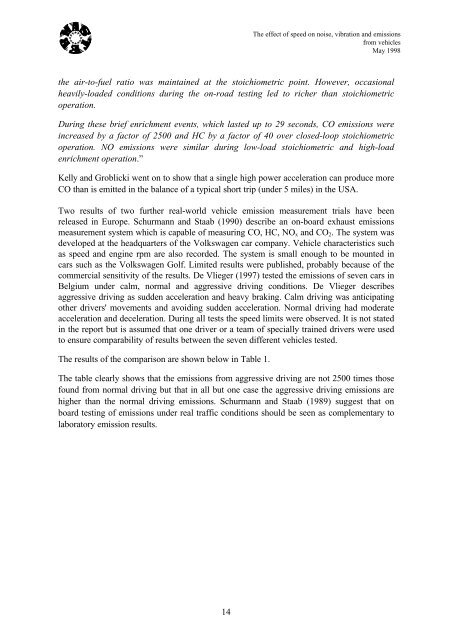appendix a - Velocidade
appendix a - Velocidade
appendix a - Velocidade
Create successful ePaper yourself
Turn your PDF publications into a flip-book with our unique Google optimized e-Paper software.
14<br />
The effect of speed on noise, vibration and emissions<br />
from vehicles<br />
May 1998<br />
the air-to-fuel ratio was maintained at the stoichiometric point. However, occasional<br />
heavily-loaded conditions during the on-road testing led to richer than stoichiometric<br />
operation.<br />
During these brief enrichment events, which lasted up to 29 seconds, CO emissions were<br />
increased by a factor of 2500 and HC by a factor of 40 over closed-loop stoichiometric<br />
operation. NO emissions were similar during low-load stoichiometric and high-load<br />
enrichment operation.”<br />
Kelly and Groblicki went on to show that a single high power acceleration can produce more<br />
CO than is emitted in the balance of a typical short trip (under 5 miles) in the USA.<br />
Two results of two further real-world vehicle emission measurement trials have been<br />
released in Europe. Schurmann and Staab (1990) describe an on-board exhaust emissions<br />
measurement system which is capable of measuring CO, HC, NOx and CO2. The system was<br />
developed at the headquarters of the Volkswagen car company. Vehicle characteristics such<br />
as speed and engine rpm are also recorded. The system is small enough to be mounted in<br />
cars such as the Volkswagen Golf. Limited results were published, probably because of the<br />
commercial sensitivity of the results. De Vlieger (1997) tested the emissions of seven cars in<br />
Belgium under calm, normal and aggressive driving conditions. De Vlieger describes<br />
aggressive driving as sudden acceleration and heavy braking. Calm driving was anticipating<br />
other drivers' movements and avoiding sudden acceleration. Normal driving had moderate<br />
acceleration and deceleration. During all tests the speed limits were observed. It is not stated<br />
in the report but is assumed that one driver or a team of specially trained drivers were used<br />
to ensure comparability of results between the seven different vehicles tested.<br />
The results of the comparison are shown below in Table 1.<br />
The table clearly shows that the emissions from aggressive driving are not 2500 times those<br />
found from normal driving but that in all but one case the aggressive driving emissions are<br />
higher than the normal driving emissions. Schurmann and Staab (1989) suggest that on<br />
board testing of emissions under real traffic conditions should be seen as complementary to<br />
laboratory emission results.


